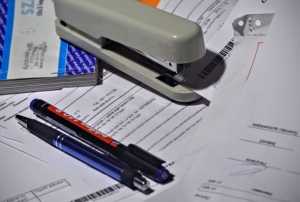Your options with Taxation of Exempt Income
PRESENTED BY PAYSTUBMAKR.COM 
Read on Taxation of Exempt Income First Chapter
25% Test
The natural business year is determined by the 25% test using the method of accounting used for the tax returns for each year involved. To figure the 25% test:
1. Compute gross receipts from sales and services for the most recent
12-month period that ends with the last month of the requested fiscal year. Divide this amount into the gross receipts of the last two months of this same 12-month period.
2. Make the same computation for the two 12-month periods immediately preceding the 12 months used in (1).
3. Compare the results; if each of the three results equals or exceeds 25%, the fiscal year is the natural business year. If the partnership, S corporation, or personal service corporation qualifies for more than one natural business year, the year producing the highest average of the three percentages is the natural business year.

Note: If the partnership, S corporation, or personal service corporation does
Not have at least 47 months of gross receipts (which may include a presence or organization’s gross receipts), it cannot use this expeditious procedure to
obtain permission to use a fiscal year (R.P. 87-32 sec 4.01(1)).
Length of Accounting Period
Generally, a corporation’s accounting period may not exceed 12 months. However, if the requirements of §441(f) are met, the corporation may elect to adopt a 52-53 week taxable year.
Short Tax Year
A short tax year is a tax year of fewer than 12 months. There are two situations that can result in a short tax year. The first occurs when the corporation is not in existence for an entire tax year. The second occurs when there is a change in accounting period. Each situation results in a different way of figuring the tax for the short tax year (Reg. §1.443-1(a)(2))
Understanding How Income Taxes Work
Not in Existence Entire Year
A tax return is required for the short period during which the corporation was in existence. Requirements for filing the return and paying the tax generally are the same as if the return were for a full tax year of 12 months that ended on the last day of the short tax year (§443(a))

Example
Corporation X came into existence on July 2, 2017. It elects the calendar year for its accounting period. Corporation X must file its return by March 16, 2018. The return covers the period July 2, 2017, through December 31, 2017.
What is US tax system structure?
Change in Accounting Period
If the corporation changes its accounting period, the tax for the short tax year is figured by placing taxable income for a short period on an annual basis.
Election of the Accounting Period
Subject to the limitations discussed below, a regular corporation may elect either a calendar year or a fiscal year (including a period of 52 or 53 weeks) by filing its first return promptly. Extreme care should be taken in the filing of the initial return. The corporation’s taxable year begins on the date on which the corporation came into existence. Not the date that it commences business. If this mistake is made on the initial return, the corporation will automatically be placed on a calendar year basis. Furthermore, the IRS has ruled that the filing of an extension for an initial return will qualify as an election for the corporation to adopt the accounting period specified on the Form 7004 (R.R. 57-589).

Changing Accounting Periods
Generally, once an accounting period has been elected, no change can be made without the corporation first having obtained the prior consent of the IRS. The IRS will not grant the difference unless it can be substantiated as being for a substantial business purpose. To get this approval, Form 1128 must be filed along with a user fee. This form must be filed by the 15th day of the 2nd month after the close of the short tax year. This short tax year begins on the first day after the end of the present tax year and ends on the day before the first day of the new tax year (R.P. 90-17).

Example
XYZ corporation uses a calendar tax year and, in 2017, wants to change to a fiscal year ending October 31. XYZ must file Form 1128 before December 16, 2017.
IRS consent not required for certain changes in E&P accounting, IRS concludes
Changes Without IRS Consent
A corporation (other than an S corporation or a personal service corporation) may change its tax year without first getting the approval of the IRS if the following conditions are met:
(a) It must not have changed its tax year within the ten calendar years ending with the calendar year in which the short tax year resulting from the change begins,
(b) Its short tax year must not be a tax year in which it has a net operating loss,
(c) Its taxable income for the short tax year must be (when annualized) 80% or more of its taxable income for the tax year before the short tax year, and
(d) It must not try to become an S corporation for the tax year that would immediately follow the short tax year required to effect the change (Reg.§1.4421(c)). 2-41

